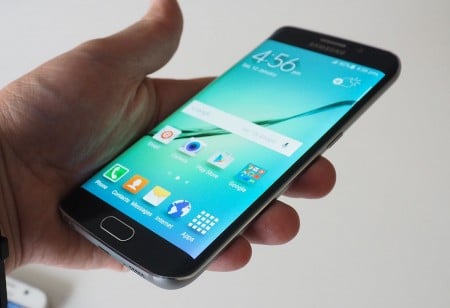How sharp can a smartphone screen be? Let’s find out, as we pull out our microscope for a quick look at the display of the Galaxy S6 due out in early April.
The fourth month of 2015 looks to be a busy one when it comes to gadgets coming out.
If you’re into your Apple goods, you’ll know all too well that two things are on the way, with the Apple Watch due out in late April, as well as a new super-slim portable from Apple that manages to out-Air Apple’s other thin computer.
Asus has a watch coming, and we’re sure there will be other gadgets too, as April is generally the time when home theatre gear — TVs and whatnot — get refreshed.
But April also means something else, as it’s generally the time when smartphones get refreshed in Australia, with March to May being the wonderful time when we see the first lot of new smartphones for the first half of the year.
And with the HTC One M9 out of the way, that can only mean Samsung’s Galaxy S6 will be next.
Launched this week, the S6 is nearly here, arriving on store shelves on April 10 and coming in a variety of prices with a bunch of new specs and features aimed at impressing.
For instance, there’s a glass and metal design, wireless charging, high-speed connections both at home (802.11ac) and while in transit (4G), and a camera that aims to really impress with low-light sensitivity and speed when you switch it on.

There are even two distinct models, one with flat edges and another with a thinner look to the edge and a curved screen, with this last model aimed at the premium end of the market that want something a little more future-friendly and individual. In case you’re curious, these are the Galaxy S6 (flat edges) and Galaxy S6 Edge (thinner edge, curved screen), with each carrying a different pricing model.
In the hands, both are very sleek pieces of gear, eliciting a feeling very much like the quality you get when you pick up an iPhone, even though the product has been made by Samsung.
If you sat on the sidelines all this time and wondered why Samsung didn’t include premium materials in its design, and hoped the company would wake up to that fact, the Galaxy S6 is that product, with metal and glass and a weight that is very comfortable to hold.

Our time with the Samsung Galaxy S6 has thus far been very short, but the camera is fast and very good at focusing quickly, even working in a macro mode the way few phones can (the way few cameras can, even), with the operating system snappy, and the overall feeling positive.
We’re already wishing the phone supported an element of ruggedisation, and some water resistance would be nice, just like in last year’s Galaxy S5, but the design differences are night and day, and gone is the S5’s plastic mediocrity replaced with a feeling of solidity on the S6 that feels comfortable to hold.
But one thing will stand out beyond all of these features simply because you have to look at it so often, and that’s the screen.
In case you haven’t heard, Samsung is going with a super-sharp well-above-Retina display for the Galaxy S6, a 5.1 inch Super AMOLED display running the resolution of 2560×1440, fuller than Full HD and packing in more pixels than any other phone we’ve seen before it.
You might have heard of the megapixel wars, but the screen pixel wars are alive and well, practically ever since Apple fired the first shot with the iPhone 4’s “Retina” display which packed in enough pixels that an arm’s length viewing of the phone meant most human eyes would have trouble finding the pixels and would therefore see the images, the text, the information more clearly.
Since then, companies like Samsung, Sony, LG, HTC, and Oppo have been doing their best to make screens better, and it wasn’t until LG launched its G3 that we saw the displays reach beyond the “Retina” look, hitting levels close to magnificent and exceptional.

With the launch of the G3, we saw a display that went beyond Full HD and managed to look as good as books, or that’s the idea in theory, with the result being something that is better on the eyes and easier to look at because you don’t see the pixels. If you did the math with that phone, you’d find 2560×1440 was packed into a 5.5 inch display, which meant super clear visuals, even more than what the Full HD panels were doing.
The reality of the situation is most people won’t get close enough to the screen to notice the pixels, but if display makers can somehow make the pixels go away, or make them small enough to not see the pixelation, people will be more thankful, and eyes will be happier.
Drag the line on the interactive screen comparison above to see the difference under the microscope between the Samsung Galaxy S6 and LG’s G3 smartphone.
In the case of the Galaxy S6, the screen is super sharp, and under our microscope, it manages to look even better than the LG G3 it competes with, telling us so much about the display and how it will be viewed.
Good luck dealing with pixels and spotting them from afar, because this is one screen that’ll make your eyes sing for joy and leave you wondering how they did that.
We should have more information on the Galaxy S6 soon, though, with a review on the way, so stay tuned.
Curious how the Galaxy S6 screen compares to the Galaxy S5? Play with the slider above!










